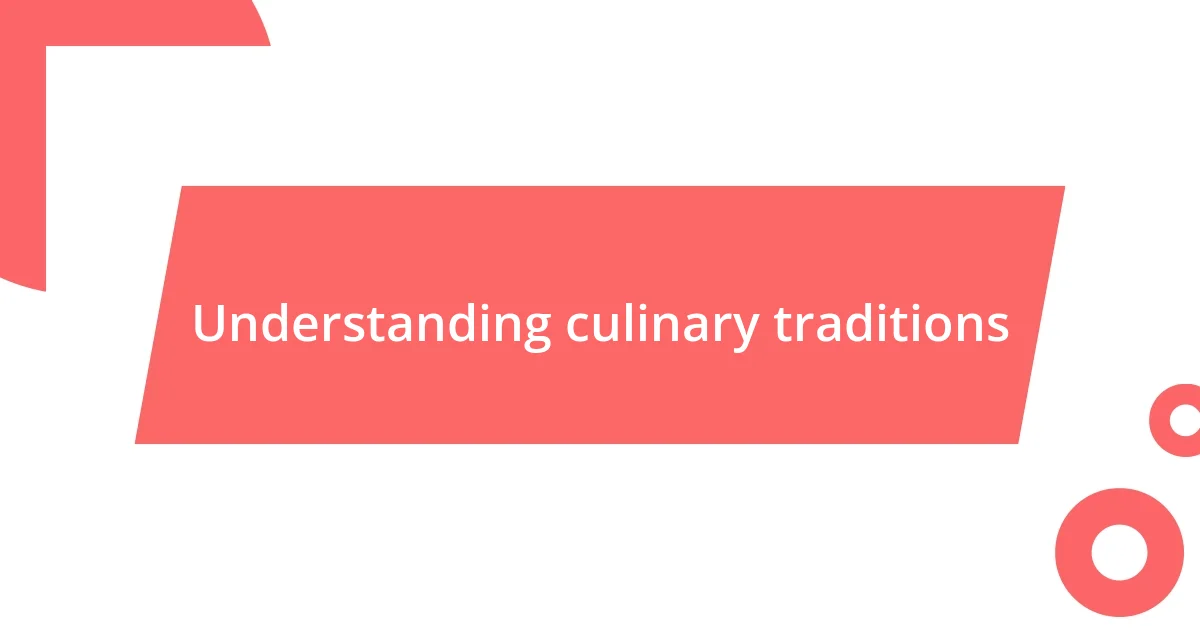Key takeaways:
- Culinary traditions are deeply rooted in cultural heritage, connecting generations and preserving unique flavors and stories.
- Key elements such as local ingredients, cooking techniques, and rituals enhance the significance of meals and foster community bonds.
- Incorporating family recipes and global cuisines into cooking enriches personal culinary experiences and honors ancestral legacies.

Understanding culinary traditions
Culinary traditions are like a tapestry woven from history, culture, and geography. I often think about the incredible meals my grandmother prepared, filled with spices and stories that shaped our family’s identity. Isn’t it fascinating how just one dish can hold generations of memories and significance?
When I travel, I love experiencing local cuisines, as they reflect the land and its people. For instance, I remember trying a hand-rolled pasta in a small Italian village, where the cook shared her recipe handed down from her mother. It made me realize that each meal can be a connection to our roots, and food often tells stories that words cannot convey.
Culinary traditions also evolve, adapting to new influences while retaining their essence. This fluidity resonates with me, especially as I witness my own cooking change over time—merging techniques from different cultures. Have you ever thought about how your favorite comfort food could transform if you added a twist from another tradition? It’s this playful exploration that keeps culinary arts lively and exciting.

Importance of cultural heritage
Cultural heritage serves as the backbone of our culinary traditions, linking generations and preserving unique flavors that might otherwise fade away. I remember the exhilarating feeling of cooking a traditional family recipe for the first time. As I stirred the pot, I felt like I was holding my ancestors’ hands, each stir connecting me through time. The aromatic blend of spices evoked memories of family gatherings and lively conversations around the dinner table, illustrating how food is so much more than just sustenance—it’s a vessel for cultural identity.
Understanding the importance of cultural heritage in culinary practices can help us appreciate the diversity of tastes and cooking techniques across the globe. Here are a few key points to consider:
- Connection to Identity: Food often symbolizes who we are, reflecting our backgrounds and traditions.
- Preservation of History: Recipes passed down through generations preserve stories and cultural significance.
- Social Cohesion: Sharing meals fosters community and strengthens bonds between family and friends.
- Innovation and Evolution: While rooted in tradition, cultural practices are adaptable, allowing us to create new experiences by blending flavors.
- Learning Opportunities: Engaging with different culinary traditions promotes cross-cultural understanding, enriching our lives through diverse perspectives.
By valuing cultural heritage, we not only enhance our cooking skills but also gain a deeper connection to the world around us. Each dish carries a piece of history, waiting to be explored and celebrated.

Key elements of culinary traditions
The heart of culinary traditions lies within the key elements that define them. One critical aspect is the use of local ingredients, which fosters a deep connection to the environment. I remember visiting a bustling farmer’s market where I discovered heirloom tomatoes and fragrant herbs that transformed my cooking. That experience reminded me how the freshest produce can elevate a simple meal, making it a genuine representation of the land.
Another essential element is the techniques used in preparation. For instance, while cooking a beloved Moroccan tagine, I found joy in mastering the slow-cooking method, which infuses the dish with rich flavors. This patience and attention to detail showcase the artistry in culinary practices. Have you ever invested time in perfecting a cooking technique? The satisfaction that comes from it is unparalleled and resonates deeply with the traditions passed down through generations.
Lastly, the role of rituals in culinary traditions cannot be overlooked. I cherish the way my family gathers every Sunday for a shared meal, where we not only savor food but also celebrate our togetherness. Rituals like these create lasting bonds and create memories that become part of our culture. What is your favorite culinary tradition, and what impact does it have on your life? It’s these experiences that enrich our understanding and appreciation of food.
| Key Element | Description |
|---|---|
| Local Ingredients | Fosters connection to the environment and enhances flavor. |
| Cooking Techniques | Showcases artistry and cultural practices through preparation methods. |
| Rituals | Create lasting bonds and memories, enhancing cultural significance of meals. |

Personal experiences with food
I still remember my childhood kitchen filled with the sweet, warm aroma of my grandmother’s freshly baked pies. Each time I stepped in, I was enveloped in a sense of comfort and nostalgia. Watching her expertly weave the crust, I felt a deep connection to her craftsmanship. It wasn’t just about the food; it was about creating memories that would last a lifetime. Isn’t it fascinating how certain smells can transport you back in time?
As I grew older, my culinary adventures expanded beyond my family’s kitchen. During a trip to Italy, I experienced the joy of a homemade pasta class. The tactile sensation of kneading the dough reminded me of my own family’s cooking sessions, but this time, it was intertwined with the vibrant culture of another country. I marveled at how food can bridge cultures, allowing us to share stories, laughter, and traditions from different corners of the world. Have you ever tried a dish that made you feel connected to a place you hadn’t even been before?
At times, I find solace in experimenting with flavors inspired by my travels. One evening, I decided to craft a fusion dish, blending Indian spices with Italian risotto. As the creamy rice absorbed the bold seasonings, I felt a thrill of creativity—like I was writing a new chapter of my culinary story. Isn’t it incredible how food allows us to express ourselves and cultivate new traditions? Each bite was not just a meal but a testament to the beauty of blending heritage with modern influences.

Learning from family recipes
There’s something truly special about learning from family recipes. I remember the first time I attempted to make my great-aunt’s famous lasagna. As I layered the pasta, my mind was flooded with memories of family gatherings where we would dig into that hearty dish, and I felt an overwhelming sense of connection to my roots. Isn’t it amazing how one recipe can encapsulate entire memories and traditions?
Navigating through the handwritten notes in my grandmother’s recipe book feels like uncovering hidden treasures. Each messy smudge and slight alteration tells a story, revealing her personality and the love she poured into each dish. It reminds me that cooking is not just about following instructions; it’s about honoring the legacy of those who came before us. Have you ever felt a sense of pride when recreating a dish that has been part of your family for generations?
Learning from family recipes also offers invaluable life lessons. I’ve found that patience is key, especially when making my father’s slow-cooked chili. As the hours pass, I take moments to reflect—on the flavors, the aromas, and my family’s history. This process teaches me that culinary traditions are living artifacts, connecting us to our lineage while allowing us to put our spin on beloved classics. How do your family recipes shape your identity and values in the kitchen?

Exploring global cuisines
Exploring global cuisines has always captivated my curiosity. On a trip to Thailand, I was introduced to the vibrant, complex flavors of street food—each vendor a storyteller, sharing their culinary heritage with every dish. I can still taste the balance of spicy, sweet, and sour in a stunning papaya salad, which made me ponder: how can such simplicity evoke such powerful emotions and memories?
I remember my first encounter with Moroccan cuisine during a dinner party hosted by a friend. The aroma of spices wafting through the air was enchanting, and I was fascinated by the communal style of eating from a shared tagine. It got me thinking: how does food foster connections, not just among those at the table, but across cultures and continents? Each bite transported me to a different world, reminding me of how beautiful and diverse our global culinary landscape truly is.
Exploring these cuisines often feels like embarking on a treasure hunt for flavors and traditions. The other day, I tried my hand at making Japanese ramen from scratch. As I crafted the silky broth and poured it over perfectly cooked noodles, I reflected on how culinary techniques differ yet also unite us. Isn’t it interesting how, despite the variations, the love for food and community lies at the heart of every culture? This exploration inspires me to appreciate not just the dishes themselves, but the rich tapestry of lives and stories behind them.

Incorporating traditions into cooking
Incorporating traditions into cooking often feels like weaving a tapestry of flavors and memories. The other evening, as I seasoned my grandmother’s stuffed peppers, I let the aroma of the herbs transport me back to her tiny kitchen. Each ingredient was a reminder of her careful hands guiding me as a child, making it hard to resist asking: how many cooking traditions evolve as we pass them down, enriching our own experiences in the process?
I distinctly recall the first time I hosted a family dinner and decided to incorporate my great-grandmother’s traditional Coq au Vin. Preparing it from scratch became an emotional ritual for me, deepening my appreciation for the past. As I watched my loved ones savor each bite, it struck me that food isn’t just sustenance; it’s a bridge linking our stories across generations. How often do we realize that the meals we cherish carry legacies that deserve to be celebrated?















